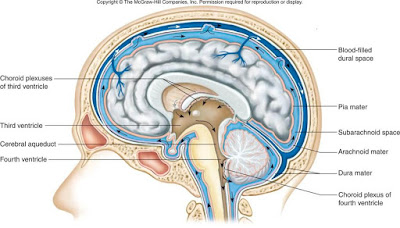Instruction: pick the one best answer. This is also useful on the USMLE step 1.
1. What is the cell body of a neuron called?
a. Ganglion
b. Soma
c. Astrocyte
d. Nissl
e. Terminal bouton
Answer: b
 A ganglion is a collection of neuron cell bodies outside of the central nervous system. The cell body of a neuron is called a perikaryon or soma. An astrocyte is a supporting cell seen in the central nervous system. The basophilic clusters of ribosomes and rough endoplasmic seen in neuron cell bodies is called Nissl, Nissl bodies or Nissl substance. The terminal bouton is the end portion of an axon. It is also called an axon terminal or end bulb. The terminal bouton will be > associated with another neuron in a synapse.
A ganglion is a collection of neuron cell bodies outside of the central nervous system. The cell body of a neuron is called a perikaryon or soma. An astrocyte is a supporting cell seen in the central nervous system. The basophilic clusters of ribosomes and rough endoplasmic seen in neuron cell bodies is called Nissl, Nissl bodies or Nissl substance. The terminal bouton is the end portion of an axon. It is also called an axon terminal or end bulb. The terminal bouton will be > associated with another neuron in a synapse.
2. Where is the ependyma found?
a. Lining ventricles
b. Lining spinal canal
c. Covering the brain
d. Covering the spinal cord
e. Both a and b
Answer: e
The ependyma lines the ventricles and spinal canal.
3. Which type of neuron is most abundant?
a. Sensory neurons
b. Motor neurons
c. Interneurons
d. Both a and b
e. All of the above
Answer: c
The vast majority of neurons are interneurons.
4. What surrounds a bundle of nerve fibers?
a. Neurium
b. Perineurium
c. Epineurium
d. Endoneurium
e. None of the above
Answer: b
The endoneurium surrounds a nerve fiber. The perineurium surrounds a bundle of nerve fibers. The epineurium surrounds a nerve.
5. Which meninx covers the brain intimately?
a. Dura mater
b. Arachnoid
c. Pia mater
d. Both a and b
e. All of the above
Answer: c
The meninges cover the brain and spinal cord. There are three: dura mater, arachnoid, and pia mater.
The dura mater is the outer meninx. The dura mater is composed of dense irregular connective tissue.
The arachnoid is made of a delicate spider web like connective tissue.
The pia mater is the innermost meninx. It covers the brain intimately.
Note from Sarah Bellham: Arachnoid is derived from the Greek word for spider. It is used in the words arachnophobia, arachnids and arachnoid.
6. Which of the following is the largest neuroglia cell?
a. Astrocytes
b. Ependymal cells
c. Oligodendrocytes
d. Microglia
e. Schwann cells
Answer: a
Neuroglia are the supporting cells of the central nervous system. Sometimes, neuroglia called glial cells or glia. Astrocytes, ependymal cells, oligodendrocytes, and microglia are all neuroglia.
Of the neuroglia cells, astrocytes are the most abundant and the largest. These are star shaped cells involved in the blood brain barrier.
Ependymal cells line the ventricles and spinal canal.
Oligodendrocytes form myelin in the central nervous system.
Microglia are the central nervous system macrophages.
Schwann cells are seen in the peripheral nervous system and are not considered neuroglia. Schwann cells are responsible for the myelination of neurons in the peripheral nervous system.
7. Which of the following is NOT considered neuroglia?
a. Astrocytes
b. Ependymal cells
c. Oligodendrocytes
d. Microglia
e. Schwann cells
Answer: e
Neuroglia are the supporting cells of the central nervous system. Sometimes, neuroglia called glial cells or glia. Astrocytes, ependymal cells, oligodendrocytes, and microglia are all neuroglia.
Of the neuroglia cells, astrocytes are the most abundant and the largest. These are star shaped cells involved in the blood brain barrier.
Ependymal cells line the ventricles and spinal canal.
Oligodendrocytes form myelin in the central nervous system.
Microglia are the central nervous system macrophages.
Schwann cells are seen in the peripheral nervous system and are not considered neuroglia. Schwann cells are responsible for the myelination of neurons in the peripheral nervous system.
8. What is the innervation of an eccrine sweat gland?
a. Cholinergic; parasympathetic
b. Cholinergic; sympathetic
c. Adrenergic; parasympathetic
d. Adrenergic; sympathetic
e. Cholinergic; motor
Answer: b
Eccrine sweat glands are innervated by the sympathetic nervous system. The neurotransmitter for the eccrine sweat glands is acetylcholine. Thus it is cholinergic.
Note from Sarah Bellham: For most postganglionic sympathetic neurons, the neurotransmitter is norepinephrine. Eccrine sweat glands are an exception to this generalization, as the innervation for eccrine sweat glands is cholinergic sympathetic.
9. What is the innervation of an apocrine sweat gland?
a. Cholinergic; parasympathetic
b. Cholinergic; sympathetic
c. Adrenergic; parasympathetic
d. Adrenergic; sympathetic
e. Cholinergic; motor
Answer: d
Apocrine sweat glands are innervated by the sympathetic nervous system. The neurotransmitter for the apocrine sweat glands is norepinephrine. Thus it is adrenergic.
source: Histology world
